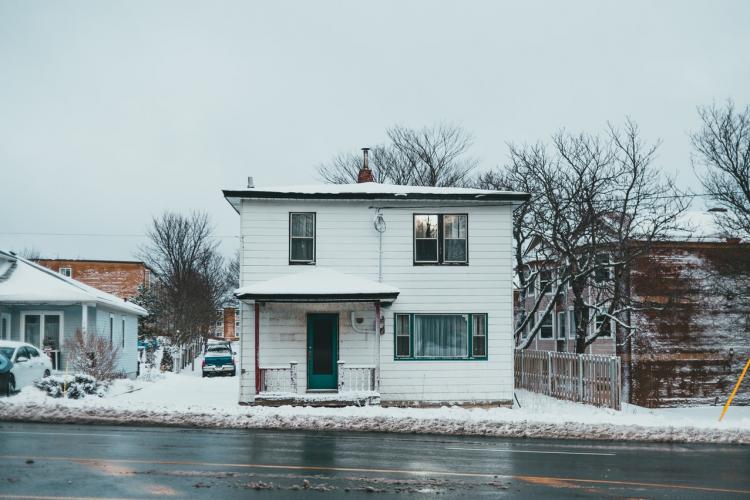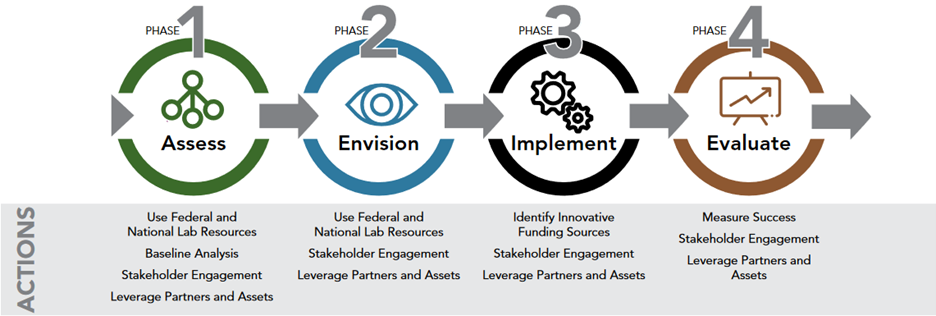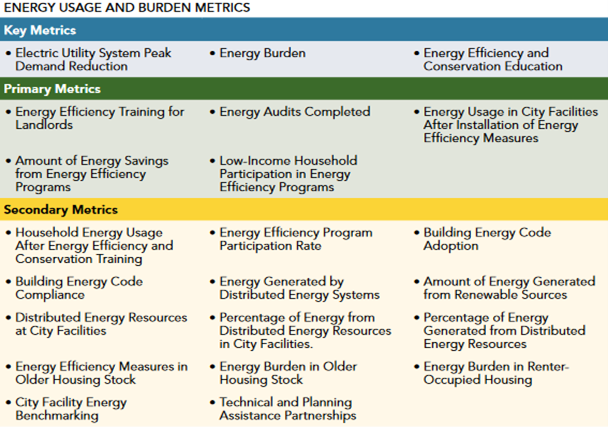
In the last several years, the Midwest’s rural and urban communities alike have seen increased risks to their infrastructure, including underinvestment, flooding, extreme heat and cold, drought and tornadoes, among others. While the threats vary by community, the need for resilience planning is consistent.
Resilience planning focuses on the ability of a community to withstand, adapt to and reduce the impact of chronic stressors, like declining populations and high energy burden, or acute shocks, like natural disasters. The considerations for each municipality, state and region are different, as are their assets and challenges. However, much of the support for planning has focused on major cities, not the smaller cities and towns that comprise the Heartland.
To address the dearth of resources on resilience planning for smaller cities, the Missouri Department of Natural Resources’ Division of Energy, with support from the US Department of Energy, led the project Partnering with Missouri Communities: Roadmap to Resilience. The project team included the Division of Energy, AECOM, Paragon Solutions, Inc and MEEA. MEEA assisted by bringing together stakeholders and experts during different phases of the project and provided technical assistance on opportunities to advance resiliency through energy efficiency.
The Roadmap is a guide for small- to medium-sized communities (defined as populations of >2,000 but <50,000) to develop a scalable resilience plan, applicable to individual businesses or community-wide planning. Among other strategies, the plan focuses on energy efficiency, key in five resilience areas: energy system, energy usage and burden, critical infrastructure, economic development and community operations. Specifically, energy efficiency reduces the energy load from critical facilities, strain on the grid during peak usage hours and the energy costs for residents and businesses. Energy efficiency activity also drives economic development.
The Roadmap project culminated in a webinar series, report and case studies of the framework’s implementation on two partner cities, Rolla and St. James. Together, the set of resources highlight technical experts, critical tools, process steps and applications of this guide on resilience planning.
Components of the Roadmap to Resilience
The Roadmap outlines four phases and six tools. The phases—Assess, Envision, Implement and Evaluate—are iterative and grounded in transparency and substantial community engagement. The four phases each leverage different combinations of the six planning tools:
- Stakeholder Engagement;
- Baseline Analysis;
- Leverage Partners and Assets;
- Identify Innovative Funding Sources;
- Utilize Federal and National Lab Resources;
- Measure Success.

Underpinning the Roadmap is a series of stakeholder meetings with partner communities and technical experts that informed the tools and process steps. The cities of Rolla, St. James and Stockton were pivotal in providing insights on the needs, challenges and assets unique to small- to medium-sized communities in the state. One of the most salient challenges that arose from workshops with partner communities was the issue of high energy burden and the need for funding and financing solutions for energy efficiency.
Energy Efficiency Elements of the Roadmap
The Roadmap implores communities to understand energy usage by critical facilities and energy burden of households through baseline analysis. It identifies several funding sources available to Missouri’s communities to implement energy efficiency measures such as the Rural Energy Savings Program and the Rural Energy for America Program. Financing mechanisms are drawn primarily from the US DOE’s Better Buildings Finance Navigator and include loans from local banks, on-bill financing, on-bill repayment, Property Assessed Clean Energy (PACE), Efficiency-As-A-Service, Energy Savings Performance Contracts and Power Purchase Agreements.
The guide notes strategies for utilities, like rebates for energy efficiency products and services and utility rate structures aligned with saving energy, i.e., inclining block rates and time-varying rates. The resulting reduced load and energy savings would allow utilities to lower energy bills, defer capital investments and invest in resilience. Cities and public utilities can also leverage the private sector for project planning and implementation through public-private partnerships.
To measure progress, the Roadmap emphasizes developing specific, quantifiable and achievable metrics for the five resilience areas previously mentioned. The figure below illustrates examples of key, primary and secondary metrics related to energy usage and energy burden. The guide recommends data collection and measurement of applicable metrics drawn from the assessment phase, specifically baseline analysis and stakeholder engagement.

Roadmap to Resilience Case Studies: Cities of Rolla and St. James
As noted, the Roadmap process and tools were applied in both the cities of Rolla and St. James. The resulting case studies represent how the resource can be applied to support different areas of a city’s infrastructure. In Rolla, the guide was used to lay a foundation for addressing energy burden city-wide and demonstrate the process for a single business. In St. James, the guide was used to advance the city’s existing grid resilience initiative.
Rolla, Missouri
The project team assessed downtown Rolla’s infrastructure and surveyed small businesses to understand—among other things—energy burden. One of the businesses surveyed, Three Sisters Consignment, noted that energy was one of its largest costs and a 20% reduction would improve viability. Initial strategies identified included highlighting the mutual benefit of efficiency investment to the proprietor and business owner, benchmarking performance, identifying appropriate measures and developing a financing plan. In addition to this smaller-scale application, the project team also performed a city-wide assessment of partners, assets, funding sources, federal resources and performance metrics that would lay the groundwork for a plan to address energy burden.
St. James, Missouri
The Roadmap was used to support the city of St. James’ grid modernization efforts in part by improving progress metrics. Baseline assessment of the St. James Municipal Utility (SJMU) system included information on customer base, debt, rate structures, staffing, management, maintenance needs and vulnerabilities. The project team identified opportunities in addition to the city’s initiatives on pole replacement, workforce development and service reliability. Those included leveraging the system’s existing advanced metering infrastructure, distributed energy resources and investment in cost-effective energy efficiency. To chart a path, the team identified the partners, assets, funding sources, federal resources and performance metrics to support new proposals to the ongoing initiative.
An Example and Resource for Midwest States
The Missouri Roadmap to Resilience project demonstrates the value of state agencies partnering with communities to develop resources that facilitate resilience planning and investment at the local level. Small- to medium-sized cities are often on the frontlines of resilience threats. Furthermore, fewer opportunities for economic development, historic disinvestment and declining populations create difficult circumstances for smaller cities to develop resilient systems. Yet, these cities can leverage the expertise of their system operators, coordinate with nearby cities and more thoroughly engage their community members in resilience planning. The project illustrates that such challenges can be addressed and assets leveraged, in part by reducing energy waste through energy efficiency.
MEEA is tracking municipal efforts and opportunities for energy efficiency. We are engaged with cities and utilities on building energy reduction strategies, including energy code adoption, benchmarking and compliance. MEEA is also tracking cities as they develop climate action plans that integrate resilience strategies, and state energy offices as they work with cities to implement programs. As these strategies and investments grow, MEEA will continue to share resources and best practices within the Midwest region.
References
Missouri Department of Natural Resources' Division of Energy. "Roadmap to Resilience." Government Resource. 2020. Digital. https://dnr.mo.gov/document-search/roadmap-resilience-pub2885